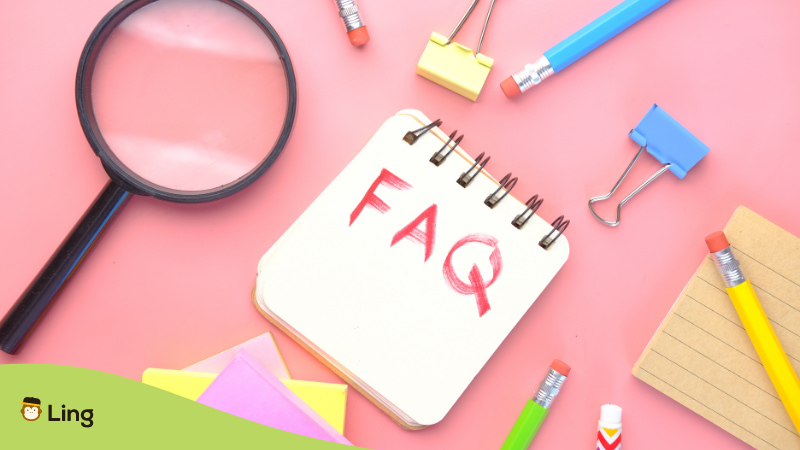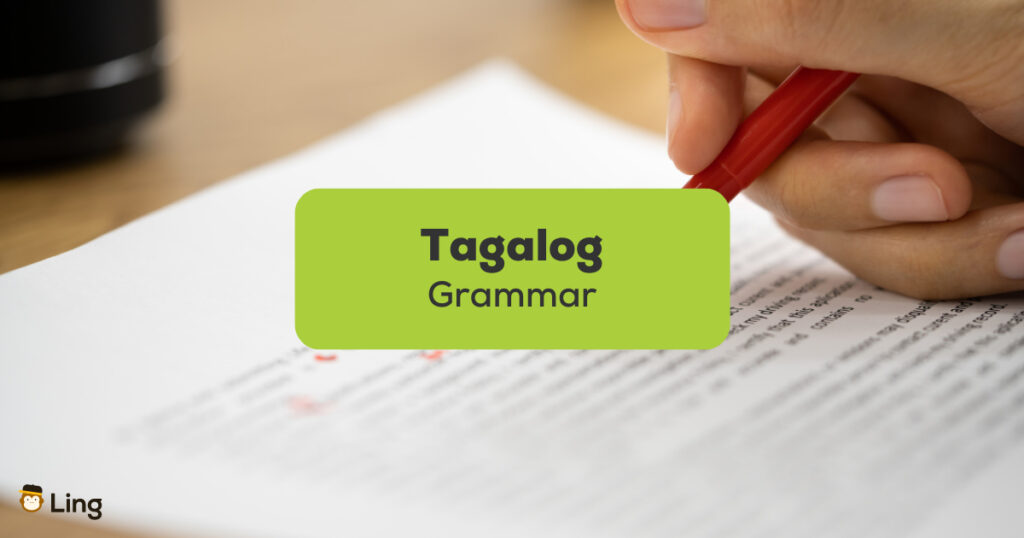Whether you are learning for fun or for seriously acquiring the language, proper grammar structure is essential to study to create exciting and impactful sentences. In fact, your level of grammatical correctness can reflect how educated and professional you are to native speakers!
To learn Tagalog, it’s important to know the rules about grammar, pronunciation, and writing. Let’s take a look at Tagalog grammar first.
Table of Contents

Tagalog Grammar: What You Need To Remember
In today’s post, we will give you a rundown on important grammatical points such as vowels and consonants (ideal for pronunciation practice), pronouns, adjectives, and sentence patterns. There are still other critical points to discuss, but this is already a good starting point for forming a sentence like a total pro.
Top Points For Learning Tagalog Grammar
If you want to learn Tagalog and speak it right away, one of the top points you focus on is understanding how basic grammar works. This Malayo-Polynesian language can be a bit tricky for English speakers, but it is definitely not impossible. BY setting aside time and practicing the language any chance that you get, we bet that your level will increase in no time.
But, let’s be honest about one thing: to learn Tagalog, you must understand that it has certain features such as the following:
- The word order is different in the sense that Tagalog sentences usually start with Tagalog verbs followed by objects or sentence functions.
- There are 5 verb focus forms as denoted by ang and ng. The Tagalog grammar focuses on actor, object, instrumental, locative, and beneficiary.
- There are tons of prepositions, but they are not all using the syllable sa.
- Some sentences can be turned into Tagalog question words by simply adding ba or na along with a rising intonation.
Markers In Some Tagalog Texts
The Tagalog language uses five vowels which are a, e, i, o, u, but please note the e is mainly used for loan words. Pure Tagalog words only use a,i,o,u. There really is nothing much different in terms of the pronunciation of the Filipino alphabet. Still, it would be best if you remembered that there are accent markers or tuldik in Tagalog to be familiar with, such as the pahilís (to denote the syllable to be stressed), paiwà (to denote glottal stop and that the vowel before it must be stressed), and pakupyâ (stress and glottal stop).
For your reference, please take note of the examples below to know better what we mean.
| English | Tagalog |
|---|---|
| friend | kaibígan |
| partner | kaíbigan |
| consent | káibigán |
| vinegar | sukà |
| vomit | suka |
| taro root | gábi |
| night | gabi |
Tagalog Pronouns
Many people can attest that pronouns can give an added headache since using the wrong one can significantly change the meaning. To help you get on your foot and really form a correct sentence adhering to Tagalog grammar rules, check out the personal and possessive Tagalog pronouns in the table below.
Degree Of Adjectives In Tagalog
Unlike other languages, denoting superlative adjectives are super fun when it comes to Tagalog. In fact, you can just simply repeat a few adjective words to show intensity. Read and review the sample change below:
| English | Tagalog | Sound |
|---|---|---|
| Very beautiful | Magandang-maganda | |
| Very smooth | Makinis na makinis | |
| Very old | Matandang-matanda | |
| Really good | Mabuting mabuti | |
| Very Effective | Mabisang mabisa |
Another way by which you express that something is of intense level is by learning how to add the following prefixes’ such as napaka and pinaka. Frequently, these are used in day-to-day conversations than the examples mentioned above I highlighted before. Review the examples below to know more about how to use it and what we really mean.
| English | Tagalog | Sound |
|---|---|---|
| Very beautiful | Napakagandang | |
| Very sparkly | Napakakinang | |
| Ugliest | Pinakapangit | |
| Best | Pinakamahusay | |
| Cleanest | Pinakamalinis |

What Is The Grammar Structure Of Tagalog?
Primarily, the grammar structure of Tagalog (also called Tagalog sentence structure) is V-S-O (Verb – Subject – Object). However, it also uses V-O-S (Verb-Object-Subject) or S-V-O when describing an event in the 2nd POV (Point of View).
Let’s describe the sentence patterns and first expand your vocabulary by giving you the Tagalog counterparts for the usual words that you will come across when creating a sentence.
- Sentence – Pangungusap
- Noun – Pangngalan
- Verb – Pandiwa
- Adjective – Pang-uri
- Adverb – Pang-abay
When it comes to forming a sentence, the basic pattern is different from English or other European languages since it does not follow the Subject – Verb- Object pattern. For instance, you can simply ask have you eaten? but in Tagalog, it must be kumain ka na ba?
In this example, kumain refers to the verb eat. Amazing, right? Also, you can use Tagalog adjectives first, like saying maganda ang babae or the girl is beautiful. The Tagalog adjective used is the word maganda. As you would probably notice, Tagalog grammar does not have the verb “to be.” Instead, it uses ang as a Tagalog particle marker.
How Do You Say Grammar In Tagalog?
Tagalog grammar is known in the Philippines as balarila (the art of correctly using Filipino grammar) or plainly grammatika (the structural rules governing the use of a language).

Frequently Asked Questions About Tagalog Grammar
What Are The 10 Parts Of Speech In Tagalog?
The 8 important parts of speech in Tagalog are:
- Pangngalan (Noun)
- Panghalip (Pronoun)
- Pandiwa (Verb)
- Pang-abay (Adverb)
- Pang-uri (Adjective)
- Pang-ukol (Preposition)
- Pangatnig (Conjunction)
- Pandamdam (Interjection)
- Pang-akop (Linking word)
- Pantukoy (Article)
Does Tagalog Have Gender?
Tagalog is a genderless language. Hence, its pronouns (personal, possessive, demonstrative Tagalog pronouns, etc.), sentence structures, and verbs don’t contain complex rules for gender. It also doesn’t have verb conjugation that expands to feminine or masculine in particular.
Although many Tagalog words are deeply rooted in Spanish, it doesn’t use the same rule for describing objects. For example, in Spanish, you would identify the table as la mesa as feminine. However, Filipinos describe it as ang mesa, which is a gender-neutral word.
Is It Hard To Learn Tagalog Grammar?
Saying if it’s easy or hard to learn Tagalog grammar totally depends on the learner’s native language. People who speak languages that are closely related to Austronesian (Malayo-Polynesian) will learn Tagalog faster because some of their native words already exist in Tagalog. Examples of countries are Indonesia, Malaysia, Hawaii, Brunei, and other South Pacific islands.
However, if you come from a European or American language background, then you may encounter hard-to-pronounce Tagalog words. But don’t worry, as there are many methods, like language learning apps, that will help you learn Tagalog faster.
Why Should You Learn Tagalog Grammar?
Tired of using broken Tagalog word combinations? Why should you learn Tagalog? This post is perfect for you as we will walk you through an overview of Tagalog grammar is the easiest way.
Aside from the easy Filipino writing system of the Filipino people, what makes the Tagalog language such an easy one to learn is the fact that it does not have complicated grammar rules. To add to that fact, the pronunciation and accent are straightforward, and even if you make a few mistakes, Filipinos will just give you a pat on your back and tell you how much they appreciate you trying to learn their beautiful language.
Unlike other nationalities, the Filipinos are one of the warmest people globally, and they are always willing to help you out learn their language even on the road! And if you can’t express something, you can just use English or Taglish.
Interestingly, if you know Spanish from the start, you can easily follow and have a good grasp of the language right away as it has dramatically influenced Tagalog. If you check the Tagalog and Spanish dictionary, you will see a number of loan words that are still being used today. Here are a few examples:
| Tagalog | Spanish |
|---|---|
| problema | problems |
| gobyerno | gobierno |
| pelikula | película |
| publiko | público |
| imahen | imagen |
| sabado | sábado |
| bulsa | bolsa |
| bráso | brazo |
| teorya | teoría |
| artikulo | artículo |
As you can find from the table above, a few letters may be different here and there, but the meaning of each is practically the same. Therefore, navigating the Tagalog language is going to be a walk in the park, especially if you understand how to use the words in a complete sentence.
Learn Tagalog And Speak Like A Pro Today!
As you reach the end of this post, we’d like to congratulate you because now you understand how basic Tagalog grammar works. If you are interested in learning Tagalog and speaking like a native speaker, we highly recommend that you continue practicing and immersing yourself in this language. You can do this by simply listening to Tagalog music, watching Filipino movies and TV series, or using an app to get the right motivation.
And speaking of applications, why not check out the Ling app? These mobile applications are all available for free, and it was established to mainly support your language journey no matter what level you are at right now. Instead of purchasing an expensive book or signing up for classes without knowing if you can really commit to learning, then using language apps can be the best thing! Download the Ling app today to kick start your language adventure on the right foot!



































































